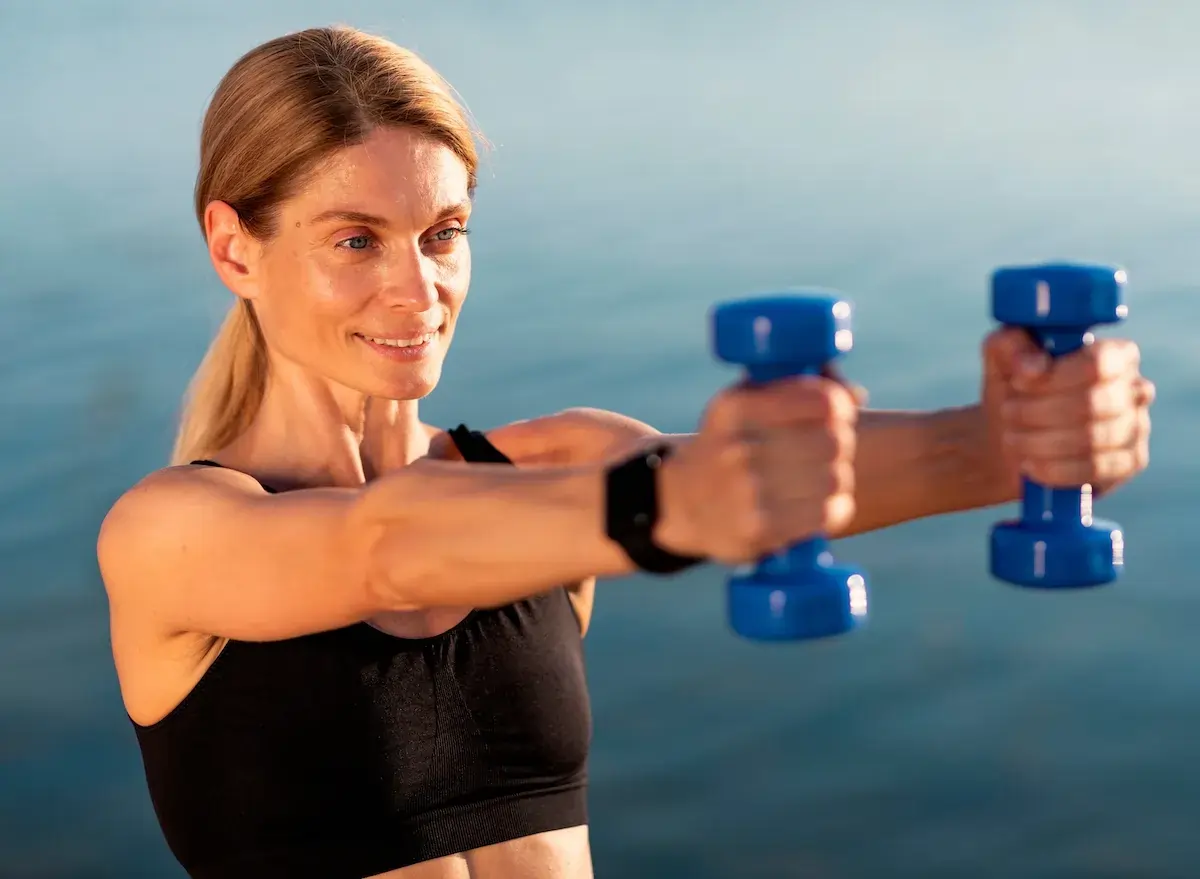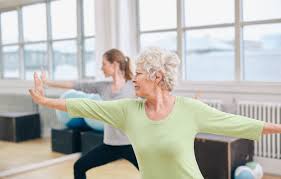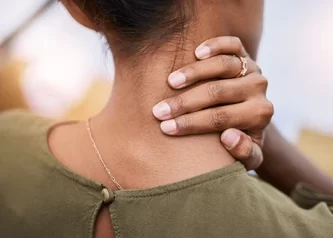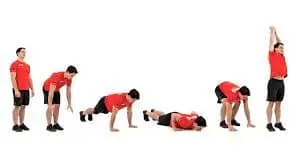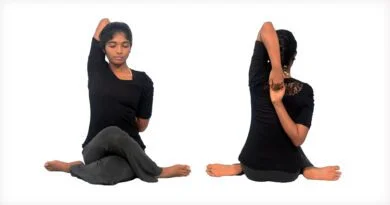19 Best Anti-Aging Exercise
The best anti-aging exercise combines strength training, cardio, flexibility, and balance work to support overall vitality. Strength training maintains muscle mass and bone density, while cardio boosts heart health and stamina. Flexibility exercises keep joints supple, and balance training reduces fall risk. A well-rounded routine promotes longevity, mobility, and youthful energy.
Introduction:
Although aging is a natural process, we can slow down its effects by exercising regularly to maintain our young age, strength, and vitality. Frequent exercise promotes good skin, increases energy, and sharpens the mind in addition to improving strength, flexibility, and balance.
This affects how a person ages physically and physiologically. There are numerous methods to exercise, and not all forms of exercise have the same anti-aging advantages.
The best 19 anti-aging exercises that you can include in your daily routine to feel and look your best at any age are shared in this article. Let’s start on a path to maintain our health, fitness, and lovely aging!
The Scientific Basis of Anti-Aging Exercise:
The body’s cells are affected by exercise. As our cells age, tissues decrease, organ function declines, and our metabolism slows down. Regular exercise, however, can help prevent this process.
- Cellular Health: Regular movement promotes muscle and tissue regeneration, and exercise improves the making of proteins that fix damaged cells. To slow down the aging process, this is important.
- Hormonal Balance: Exercise helps in the regulation of aging-related hormones including growth hormone. This can support general vitality, fat metabolism, and muscular maintenance.
- Improved Circulation: Exercise increases circulation, which increases the amount of oxygen and nutrients that reach the cells. Strong tissues and youthful skin depend on improved blood flow.
- Decreased Inflammation: While chronic inflammation has been linked to rapid aging, regular exercise has been proven to reduce systemic inflammation, which may help fend off age-related conditions like heart disease, arthritis, and cognitive decline.
- Telomere Length: As humans age, the telomeres that protect the ends of chromosomes shorten, making cells more unstable. It has been proven that exercise maintains telomere length, which helps to prolong the health of our cells.
Types of Anti-Aging Exercises:
Combining different kinds of exercise is the most effective way to take on the many components of aging. The most effective ones are as follows:
Strength Training (Resistance Exercise)
Strength training helps maintain bone density and muscular mass, both of which naturally decrease with age, making it an essential anti-aging exercise. Loss of muscle can cause weakness, a slowed metabolism, and a higher chance of falling. One way to minimize some of the effects is through strength training.
Cardiovascular Workouts
Cardiovascular workouts improve circulation and heart health, all of which are important as we age. They increase stamina, lower blood pressure, and lower the risk of cardiovascular disorders. Additionally, cardiovascular exercises promote the release of endorphins, which aid in mood control and stress reduction two factors that could contribute to aging.
Mobility and Flexibility Training
As we age, our flexibility continues to decline, resulting in stiffness and a reduced range of motion. Including mobility and stretching exercises in your routine can help you maintain your posture, increase your flexibility, and lower your risk of injury. Particularly helpful for improving flexibility and developing a mind-body connection are yoga and Pilates.
Exercises for Balance and Coordination
As people age, their balance worsens, increasing their risk of fractures and falls. You can maintain functional independence, improve stability, and avoid falls by improving your balance and coordination. Exercises that strengthen the lower body and core muscles while improving coordination include tai chi and balancing exercises.
HIIT, or high-intensity interval training
Moments of intensive activity are interspersed with rest or low-intensity movement intervals in HIIT. Human growth hormone (HGH), an important hormone involved in fat loss and muscle maintenance, has been proven to be produced more when this technique is used. A more youthful appearance and energy are a result of improved cardiovascular health, endurance, and body composition, all of which are improved by HIIT exercises.
Advantages of Exercises:
Regular physical activity has a major effect on promoting general health and slowing down the aging process. Exercises that promote anti-aging can improve your quality of life, mental health, and physical health as you age.
The following are the main advantages of anti-aging exercises:
Increases Strength and Muscle Mass
By promoting the growth and maintenance of lean muscle mass, strength training activities keep the body strong and functional. Keeping up muscle mass as we get older:
- Improves coordination and balance
- lowers the chance of fractures and falls
- Maintains a healthy body weight and metabolism.
- Increases the general strength and stamina of the body.
Improves Bone Health
As people age, their bone density declines, raising their risk of fractures and diseases like osteoporosis. Walking and strength training are examples of weight-bearing activities that can increase bone density, lower the risk of osteoporosis, and strengthen bones. Advantages consist of:
- A higher density of bone mineral
- Decreased chance of fractures
- Increased stability of the joints
- Better posture
Improves Joint Mobility and Flexibility
As people age, their flexibility tends to decline, resulting in stiffness and a restricted range of motion. Frequent yoga, pilates, and stretching can increase the range of motion, joint mobility, and flexibility. Advantages include:
- Improved mobility and flexibility of the joints
- Increased suppleness of the muscles
- Decreased chance of developing arthritis and joint pain
- Better posture and more effective movement
Increases Balance and Flexibility
Our ability to balance decreases with age, increasing the risk of falls. To increase stability and reduce the risk of falls, it is important to engage in exercises that focus on balance, coordination, and core strength, such as yoga, tai chi, or balancing exercises. Advantages consist of:
- Improved coordination and balance
- Increased stability and core strength
- Decreased chance of accidents and falls
- Increased independence and mobility
Improves Posture
Posture can be improved by strengthening the back, shoulders, and core muscles. As people age, their posture becomes worse because of weak muscles. Improved posture increases one’s overall physical appearance and reduces neck and back pain. Advantages include:
- Stronger muscles in the neck, back, and abdomen
- Better alignment of the spine
- Decreased back and neck pain and stiffness
- More self-assured movements and looks.
Improves Cardiovascular Health
Walking, running, cycling, and swimming are examples of cardiovascular exercises that are essential for preserving heart health as we age. These workouts increase blood flow, decrease blood pressure, and minimize the risk of diabetes, heart disease, and stroke. Important advantages include:
- Improved circulation and a stronger heart
- Reduce cholesterol and blood pressure.
- Increased endurance and lung capacity
- Improved control of blood sugar levels
Improves mental capacities
It has been proven that physical activity improves mental ability and brain health. Frequent exercise helps to improve memory, focus, and mental acuity by increasing blood flow to the brain. Important advantages include:
- Improved focus and memory
- Dementia and cognitive decline risk reduction
- Improved mental clarity and mood
- Improved quality of sleep
Promotes Skin Health
By increasing blood circulation, exercise helps the skin receive more oxygen and nutrients, resulting in healthier, more radiant skin. Exercise stimulates the creation of collagen, which helps to decrease drooping skin and wrinkles. Among the advantages are:
- Improved texture and tone of the skin
- Firmer skin due to increased collagen synthesis
- Reduced visibility of wrinkles and fine lines
- Sweating promotes better refreshing.
Supports Healthy Weight Control
Maintaining a healthy weight becomes more difficult as we age since our metabolism begins to slow down. This is countered by regular exercise, which increases metabolism, burns calories, and reduces body fat. Advantages include:
- Improved metabolism of fat
- Keeping a healthy weight
- Decreased risk of diseases linked to obesity
- Improved energy
Increases Longevity
Regular exercise contributes to a longer, healthier life, which is one of its most important advantages. Being physically active lowers the risk of developing chronic illnesses including cancer, diabetes, and heart disease, which can limit life expectancy. Advantages consist of:
- Reduced chance of dying young
- Decreased chance of developing age-related disorders and chronic diseases
- Longer life expectancy
- A higher standard of living
Promotes Mental Wellness
It is often known that exercise improves mental health and mood. Endorphins are naturally occurring mood stimulants that are released while you exercise. As we age, tension, worry, and depression all become increasingly common. Regular exercise can help manage these conditions. Important advantages include:
- Decreased signs of anxiety and depression
- Improved mood and mental health in general
- A greater sense of confidence and self-worth
- Better sleep habits
Encourages Social Activity and Emotional Health
Participating in physical activities promotes social interaction and emotional well-being, particularly when done in group settings such as fitness classes, walking clubs, or sports teams. As we age, loneliness can be lessened by exercising, which can make you feel more connected to people.
- Strengthens connections with others
- Promotes positive interactions with others
- Encourages a feeling of community and belonging
- Increases happiness and mental strength
Before starting a fitness program, take into consideration the following safety precautions:
To get the maximum benefit out of any exercise program, a few measures should be followed before beginning. For advice on which exercises are best for your particular issue, consult your doctor or physical therapist.
When you are in pain, it’s important to listen to your body and avoid hurting yourself. Although the fact that soreness is a typical side effect of exercise, chronic or severe pain could indicate overworking.
Repetitive injuries can be avoided by maintaining correct posture and technique. If you’re not sure how to set up a workout routine, think about consulting a physician. Your muscles and joints will be better prepared for exercise if you warm up before beginning.
Exercise Routine for Anti-Aging:
Cardio, strength training, flexibility, and balance exercises should all be included in an anti-aging exercise regimen. To keep you feeling young and revived, try this weekly routine:
- Day 1: Strength training for the entire body
- Day 2: Core and Cardio
- Day 3: Flexibility and Mobility
- Day 4: Balance and Stability
- Day 5: HIIT Training
- Day 6: Gentle activity and Rest
Anti-aging Exercise:
Walking
Walking can be a great anti-aging workout and is among the easiest, simplest, and most effective types of exercise. It has numerous health advantages that help delay the aging process on both a mental and physical level.
- Keep your head up and look forward, not at the floor, as you stand upright.
- Do not slouch or hunch; instead, relax your shoulders.
- Use your core: To stabilize your spine, keep your abdominal muscles slightly taut.
- Swinging your arms will improve upper body movement and raise your heart rate. Swing your arms naturally while keeping your elbows bent at a 90-degree angle.
- If you’ve never gone for a walk before, start with 20 to 30 minutes and work your way up to longer walks and faster speeds.
- Take five to ten minutes to cool down after your walk.
- To return your heart rate to normal, gradually reduce the speed to a leisurely walk.
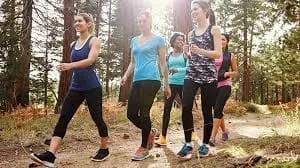
Aerobics
Exercises that increase heart rate and improve cardiovascular health are referred to as aerobic exercises. As it maintains both physical and mental health, aerobic exercise is an excellent strategy for preventing the effects of aging.
- One of the best strategies to stay young, healthy, and fit as you age is to engage in aerobic activity.
- It strengthens muscles, increases metabolism, improves mental health, and improves cardiovascular health.
- Finding something you enjoy and can do regularly is essential, irrespective of your preferred aerobic activity dancing, swimming, walking, or anything else.
- You will feel better and be better equipped to face the difficulties of aging with power and energy if you are more active.
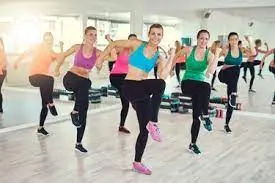
Cycling
People of all ages and fitness levels can benefit from this low-impact exercise, whether they want to ride indoors or outside. You can keep your body and mind strong and healthy as you age by including cycling in your routine. This will improve your general quality of life and keep you active for many years to come.
- When riding your bicycle outside, make sure the bike is suitable for the type of surface (for example, a road bike for smooth roads, a mountain bike for off-road riding, or a hybrid bike for a combination of both).
- Start with shorter rides at a comfortable speed if you’ve never ridden a bicycle before or haven’t been active in a long time.
- Try for 15 to 20 minutes at a moderate speed; as you feel more relaxed, progressively extend the duration and intensity.
- Ensure that the bicycle is fitted to your body.
- To prepare your muscles, always start your cycling workout with a gradual, five to ten-minute warm-up.
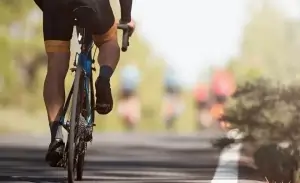
Tai chi
For its health advantages, especially as an anti-aging exercise, tai chi is done by many. It is a great option for anyone who wants to improve their mental health, flexibility, and balance as they age because it is available to people of all ages and fitness levels.
- It’s important to begin with the fundamentals if you’re new to Tai Chi.
- Start by mastering the fundamental motions, such as “Cloud Hands” and “Golden Rooster Stands on One Leg.”
- A key component of Tai Chi is breathing.
- Instead of using stiff or jerky movements, tai chi promotes a fluid, relaxing motions.
- Observe how your body feels as you progress through each pose slowly and gently.
- Don’t hurry; give your joints and muscles time to organically strengthen and stretch.
- The practice of tai chi involves both mental and physical aspects.
- With every movement, concentrate on remaining mindful and in the moment.
- Since this mental activity improves focus and encourages relaxation, Tai Chi can be thought of as a type of moving meditation.
- It’s important to be regular.
- To get maximum benefit out of Tai Chi, practice at least two or three times every week.
- If done regularly, even a short practice session (15–30 minutes) can have an immense effect.
- If at all possible, think about participating in a class conducted by a licensed Tai Chi instructor.
- To minimize injury and maximize the practice’s advantages, a teacher may help in making sure you’re doing the exercises correctly.
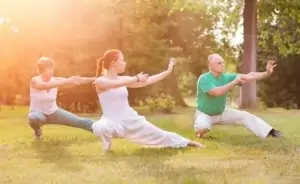
Dumbbell rows
- Place your knees slightly bent and your feet shoulder-width apart.
- Using a neutral grip, hold a dumbbell hand with the palms facing inward.
- With your chest pointing down and your back flat, lean forward at the hips.
- For support, keep your knees slightly bent.
- To keep your spine stable while lowering your body toward the floor, bend at the hips.
- You want your chest to be nearly equal to the floor.
- To maintain your lower back, keep your core strong.
- To put your arms in a natural position, bend your elbows slightly.
- Make sure your shoulders are not rounded; rather, bring them back.
- Your upper back muscles will contract more effectively as a result.
- Pull both dumbbells toward your body while keeping your elbows tight to your body and your arms out to the floor.
- At the top of the movement, your shoulder blades should be pressed together and your upper arms should be parallel to the floor.
- As you pull the weights, concentrate on pulling your elbows back and maintaining their alignment with your body.
- Extending your arms back toward the floor, carefully return the dumbbells to the beginning position.
- For the best muscle engagement, keep the action continuous and intentional, paying particular attention to the lowering phase.
- Then return to your neutral position.
- Then relax.
- Repeat this exercise 5 to 10 times.
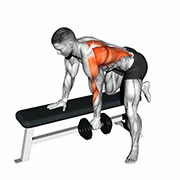
Squats
- Place your feet shoulder-width apart and point your toes slightly outwards as you stand.
- Keep your chest high and your back straight while using your core.
- For balance, you may put your hands on your hips or keep your arms out in front of you.
- As though you were sitting in a chair, start by bending your knees and pushing your hips back.
- Make sure your knees don’t extend past your toes and maintain your weight on your heels.
- Lower yourself as far as your range of motion allows, ideally until your thighs are parallel to the floor, or even lower if you are able.
- To straighten your legs and get back to the beginning posture, push through your heels.
- As you rise, maintain a strong core and squeeze your glutes.
- Then return to your neutral position.
- Then relax.
- Repeat this exercise 5 to 10 times.
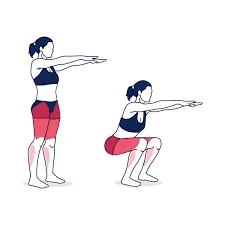
Plank
- Laying face down on the floor or mat is the first step.
- With your forearms flat on the floor, position your elbows exactly beneath your shoulders.
- Make sure your toes are tucked under and your feet are hip-width apart.
- Raising your hips off the floor will help you balance on your forearms and toes.
- Try for a straight body alignment from head to heels; do not droop at the hips or lift your buttocks excessively.
- To balance your body, tense your glutes, engage your thighs, and tighten your abdominal muscles.
- Hold this posture while taking regular breaths.
- Hold for a few seconds at first, then as you gain strength, progressively extend the duration.
- When you’re ready to finish, carefully return to the ground with your body.
- Then return to your neutral position.
- Then relax.
- Repeat this exercise 5 to 10 times.
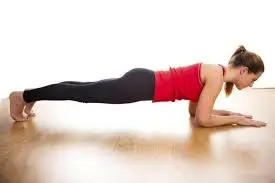
Tree Pose
- Start by placing your feet together, keeping your arms by your sides, and standing straight in Mountain Pose.
- To find your balance and center yourself, take a few deep breaths.
- Ground your left foot firmly into the ground as you gradually shift your weight onto it.
- Don’t lock your left knee; instead, keep it slightly bent.
- Raise your right foot off the ground and press its sole against your left ankle, calf, or inner thigh (don’t put it on your knee).
- For stability, put your leg and foot together.
- You will have more balancing challenges the higher you raise your foot, but it’s important to avoid pressing your foot against your knee.
- In front of your chest, place your hands together in the Anjali Mudra, or prayer position.
- As an alternative, you can relax your shoulders and raise your arms upward with palms facing one another.
- To improve your balance, find a point in front of you to concentrate on.
- Try to maintain the position for a few seconds, or longer if you feel comfortable while maintaining a constant look.
- Return to Mountain Pose after carefully lowering your right foot back to the floor to exit the pose.
- Then return to your neutral position.
- Then relax.
- Repeat this exercise 5 to 10 times.
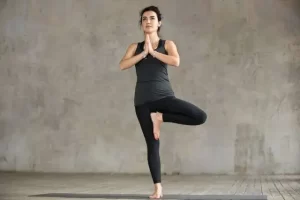
Child’s Pose
- Start by spreading your knees about hip-width apart on the mat.
- Move your hips closer to your heels as you sit back onto them.
- You can support yourself by positioning a cushion or block between your hips and heels if this feels uncomfortable.
- Reach your arms out in front of you as you slowly go down your body toward the floor.
- Maintain your forehead on the mat (or, for added comfort, a pillow if necessary).
- Depending on what feels most calming, you can either extend your arms forward with your palms facing down or lay them along your body with your hands facing up.
- Take calm, deep breaths to let your body settle into the pose.
- As you inhale, concentrate on expanding your abdomen and ribs, and as you exhale, relax.
- For however long you feel comfortable, hold the Child’s Pose.
- You can use it as a restful pose to calm your thoughts or as a transition between more challenging poses in a yoga flow.
- Then return to your neutral position.
- Then relax.
- Repeat this exercise 5 to 10 times.
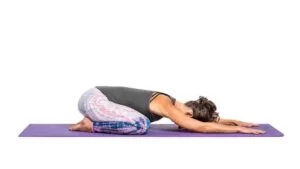
Push-ups
- With your hands slightly wider than shoulder-width apart, start in the high plank posture.
- Your body should be in a straight line from your head to your heels, with your feet hip-width apart.
- Don’t allow your hips to drop or push your butt upwards.
- Look down at the floor to keep your neck neutral and engage your core.
- Bend your elbows to a 45-degree angle and slowly drop your body toward the floor, being careful not to spread them out too far.
- Try to drop your chest to just above the floor while maintaining a straight line between your hips and chest.
- Your forearms should remain upright while your elbows point slightly outward.
- To get back to the beginning position, push through your hands and straighten your arms.
- Avoid allowing your hips or back to drop and maintain a strong core.
- Then return to your neutral position.
- Then relax.
- Repeat this exercise 5 to 10 times.
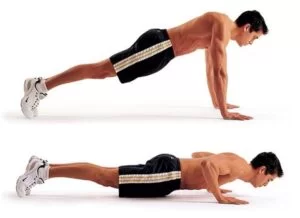
Russian Twists
- Settle down on the floor with your knees bent and your feet level.
- Maintain a straight spine while bending your upper body slightly so that it is at a 45-degree angle to the floor.
- To increase the difficulty of the exercise, raise your feet off the ground while maintaining a 90-degree bend in your knees (you can start with your feet on the floor).
- In front of you, hold your hands together or, for more resistance, grip a medicine ball, weight, or kettlebell.
- Turn your body to one side while placing your weight or hands on the floor next to your hip.
- For the rotation to be easier, your eyes should follow your hands.
- When twisting, try to use your obliques, which are the muscles on either side of your body.
- Make sure your back is straight; do not round it.
- Reposition your hands in the middle while keeping your back slightly leaned to keep your core active.
- Now turn your body to the other side and put your weight or hands down to the floor on the opposite side of your hip.
- Remember to maintain control over the action and concentrate on using your obliques.
- Keep switching sides and twisting back and forth.
- Keep your core active during the movement and do it slowly and carefully.
- Then return to your neutral position.
- Then relax.
- Repeat this exercise 5 to 10 times.
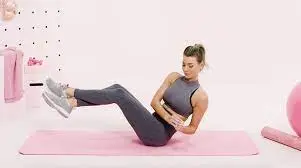
Lunges
- With your arms by your sides and your feet hip-width apart, take a confident posture.
- With your right leg, take a large step forward while maintaining an upright chest and a front-facing look.
- Bend both knees to get your body down nearer the floor.
- Your rear knee should drop toward the floor without contacting it, and your front knee should be positioned over your ankle (not past your toes).
- For balance, make sure to maintain a straight back and use your core.
- Then return to your neutral position.
- Then relax.
- Repeat this exercise 5 to 10 times.
- Repeat the movement, switching legs with each lunge, starting with your left leg.
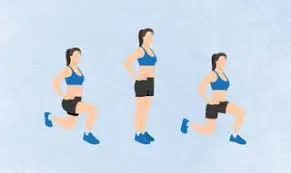
Burpees
- Place your feet shoulder-width apart and keep your arms by your sides as you stand.
- Maintain a raised chest and an active core.
- To squat, place your hands on the floor in front of you and bend your knees and hips.
- To come down in a high plank posture, jump back with your feet.
- Between your head and your heels, your body should make a straight line.
- Avoid allowing your hips to fall by maintaining a firm core and a flat back.
- Move your feet back to the squat posture by jumping them forward and landing them close to your hands.
- Jump up from the squat posture and extend your arms overhead.
- Then return to your neutral position.
- Then relax.
- Repeat this exercise 5 to 10 times.
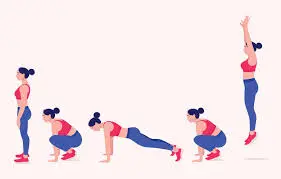
Hanging Leg Raise
- Locate a strong workout bar or pull-up where you can hang with your feet raised.
- A secure bar that allows you to completely extend your legs is essential.
- Place your hands shoulder-width apart and grasp the bar with an overhand hold, palms facing away from you.
- Keep your elbows slightly bent (don’t lock them out) and let your body hang with your arms fully extended.
- Pull your belly button toward your spine to activate your core before starting the exercise.
- Maintain a neutral posture with your legs straight.
- You must perform the movement with control; don’t swing your body.
- Using your lower abdominal muscles, slowly elevate your legs.
- Lift your legs until they are parallel to the floor, or higher if you can manage it (ideally, your legs should make a 90-degree angle with your body, but you may also try elevating them until your feet are at chest height).
- Keep your legs straight and together.
- Avoid using force or swinging your legs; instead, be sure your core is doing the lifting.
- Controllably return your legs to the starting position by lowering them slowly while resisting gravity.
- Keep your legs from dropping too soon.
- Don’t let your shoulders or back sag; instead, keep your core strong.
- Then return to your neutral position.
- Then relax.
- Repeat this exercise 5 to 10 times.
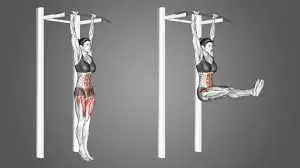
Hip flexor stretch
- Take an upright posture and lunge forward with one foot.
- Make sure your front knee is at a 90-degree angle and your back knee is on the ground.
- Keep your chest up and your hips straight.
- Feel the flexor area on the rear leg, which is the front of your hip, stretch as you push your hips forward.
- Hold this posture for a few seconds while continuing to take deep breaths.
- Then return to your neutral position.
- Then relax.
- Repeat this exercise 5 to 10 times.
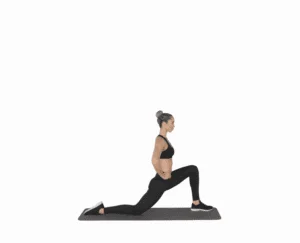
Knee-to-chest stretch
- Place your feet level on the floor, hip-width apart, and bend your knees while lying on your back on a comfortable surface, such as a yoga mat or carpet.
- Maintain your arms at your sides.
- Using both hands, hold one leg immediately below the other as you slowly pull it toward your chest.
- To keep your lower back from arching and to stabilize your body, contract your core muscles.
- Feel your hips and lower back extend as you hold the pose for a few seconds.
- For more core engagement, consider gently pressing your back into the floor while keeping your knee pulled toward your chest.
- Return to the starting position by slowly lowering your leg while maintaining control over the movement.
- Then return to your neutral position.
- Then relax.
- Repeat this exercise 5 to 10 times.
- Make the same movement with your other leg.
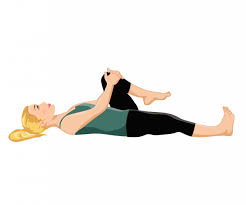
Heel-to-toe walking
- Place your feet hip-width apart and stand up. Stand up straight and contract your core.
- Place the heel of your right foot directly in front of your left toe as you take a step forward with your right foot.
- With every step, the toe and heel should come into contact or almost so.
- In the same way, keep walking by putting your left heel in front of your right toe.
- With every step, concentrate on maintaining your balance and maintaining a straight posture.
- For about 10 to 20 steps, depending on your space, keep taking alternating steps while moving in a straight line.
- Try walking in a straight line without looking at your feet to make it more challenging.
- This will help you balance and concentrate more on the stability of your core.
- Then return to your neutral position.
- Then relax.
- Repeat this exercise 5 to 10 times.
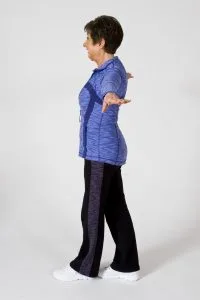
Iliotibial band stretch
- Take an upright position with your feet hip-width apart.
- Throughout the stretch, maintain your body’s stability by using your core muscles to support your lower back.
- Make sure your shoulders are not bent over.
- Start by crossing your right leg at the ankles over your left leg.
- Lean your upper body to the left while slowly moving your hips to the left.
- The IT band is situated on the outside of your right thigh and hip, and you should feel a slight strain there.
- Maintain a straight line from your head to your feet, keeping your chest up straight and avoiding a forward bend at the waist.
- For a few seconds, hold the stretch while taking slow, calm breaths.
- The outside of your thigh should feel slightly stretched, but don’t push yourself too hard to the point of pain.
- It should be difficult but not uncomfortable to stretch.
- Uncross your legs and perform the same stretch on the opposite side to lengthen the left IT band.
- Move your hips to the right and cross your left leg over your right.
- Hold the left side stretch for a few seconds.
- Then return to your neutral position.
- Then relax.
- Repeat this exercise 5 to 10 times.
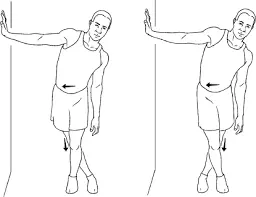
Jumping jacks
- With your arms by your sides and your feet together, take a confident posture.
- To support your lower back, maintain a straight posture and contract your core muscles.
- Elevate your arms high and jump with both feet out to the sides.
- Your feet should be shoulder-width apart, and your arms should remain straight.
- Lower your arms back to your sides to get your knees together to jump back to the beginning position.
- Throughout the action, keep your breathing constant.
- Breathe in as you leap out and out as you land back where you were before.
- Then return to your neutral position.
- Then relax.
- Repeat this exercise 5 to 10 times.
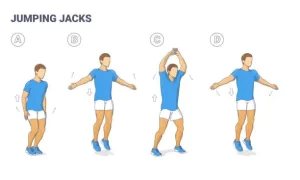
What precautions should be followed when working out?
Setting priorities for safety is important when doing anti-aging workouts to make sure you’re getting the advantages of exercise without running the danger of strain or injury.
Here are a few important safety precautions to think about:
- See a Physician Before Beginning
Before beginning a new exercise program, it’s important to speak with a healthcare professional if you’re new to exercising or if you already have health issues (such as diabetes, arthritis, or heart disease). In addition to offering advice on any safety measures you should take, they can suggest exercises that are specific to your needs.
- Properly Warm Up and Cool Down
Warm-Up: To get your muscles and joints ready for more intense action, warm up before starting any workout session. To improve mobility and blood flow, this can involve dynamic stretches like arm circles and leg swings as well as mild aerobic exercises like brisk walking or cycling.
Cool-Down: To help relax muscles, increase flexibility, and avoid stiffness, stretch gently after working out. Additionally, this will lessen the chance of pain and injury.
- Begin slowly and make progress over time.
Ease into Exercise: Don’t rush right into strenuous workouts if you’ve never worked out before or haven’t done so in a long time. As your level of fitness increases, progressively increase the duration and intensity of your workouts from low-impact ones like walking or moderate stretching.
Take It Slowly: Pay attention to your body’s signals and avoid overstressing them. To avoid overtraining and injury, gradually increase the length and intensity of your workouts.
- Use the Right Form and Technique
Pay Attention to Form: To prevent unnecessary strain or injury, make sure you use proper technique whether practicing strength, aerobic, or flexibility workouts. Incorrect motions and bad posture can result in joint pain, strained muscles, or even more severe injuries.
Think About Professional Guidance: If you’re not familiar with a particular activity, taking a class or seeing a professional personal trainer can help make sure you’re doing the movements correctly. This is especially important for strength training and more complicated exercises like Pilates or yoga.
- Keep Yourself Hydrated
Drink Water: It’s important to stay hydrated, especially when working out. Dizziness, cramping in the muscles, and exhaustion are all symptoms of dehydration. Water consumption should be a top concern before, during, and after your workout, particularly if you’re doing longer or more strenuous sessions.
- Pay Attention to Your Body
Avoid Overexertion: Stop exercising right away and take a break if you have any pain, lightheadedness, or discomfort. Ignoring pain might cause harm and limit your development. Recognize the difference between real pain and typical muscle tiredness.
Rest When Needed: It’s important to take rests when exercising, particularly for senior citizens. Excessive training can raise the risk of injury and cause exhaustion. Recovery requires that you include rest days in your weekly schedule.
- Put on the Proper Clothes
Proper Footwear: Select shoes that offer the right amount of support for your activity. Jogging shoes, for instance, are made for jogging, but high-impact workouts like weightlifting may call for supportive footwear.
Comfortable Clothes: During your training, dress in loose, breathable clothes that promote flexibility and keep you feeling comfortable.
Proper Equipment: Ensure that any machines, weights, or resistance bands you use are in good working order and level with you.
- Adjust Exercises for Health or Mobility Concerns
Exercises should be modified so that they account for joint conditions such as osteoporosis, arthritis, or other conditions. For instance, prioritize low-impact aerobic exercises like swimming and walking over high-impact ones like sprinting and jumping. Additionally, there are mobility and balancing exercises that are milder on the body.
Use Devices or Supports: For added stability, utilize chairs, resistance bands, or balancing aids, particularly while performing balance exercises or when working with restricted mobility.
- Watch for warning indications.
Be Aware of Warning Signs: Stop exercising right away and get medical help if you suffer from symptoms like chest pain, shortness of breath, lightheadedness, or extreme tiredness. These might indicate more significant health problems.
- Track Duration and Intensity
Don’t Overdo It: Depending on your level of fitness, progressively increase the duration and intensity. Don’t feel the need to push yourself too hard; moderate intensity is enough to provide anti-aging advantages. Build up to 30 to 60 minutes of exercise many times a week by starting with shorter sessions.
- Make Use of Proper Breathing Methods
Don’t Hold Your Breath: When exercising, make sure your breathing is regular and consistent. When raising weights or applying power during strength training, exhale, and when reducing the weight, inhale. This lowers the chance of fainting or dizziness and helps sustain oxygen flow.
- Rest and Recovery
Make relaxation a Priority: As you get older, it’s especially important to take enough time to relax and recover between workouts. After exercise, muscles and joints require time to heal, which can help avoid overuse issues like stress fractures or tendinitis.
Recovery Techniques: Consider incorporating rest days into your schedule or doing tough activities like stretching or walking.
- Create a Helpful Environment
Work Out in a Safe Environment: Make sure the area is secure whether you’re exercising at home or the gym. Make sure the workout equipment is set up correctly and clear away any potential risks such as wander cables or carpets.
Use Help When Needed: When experimenting with new exercises or equipment, it can be helpful to have a workout partner or personal trainer. They can offer support and help make sure you are performing the movements correctly.
When should you stop working out?
For anti-aging reasons, in particular, understanding when to stop exercising is as important as learning how to do it well. Paying attention to your body is essential for preventing injuries and making sure your workouts are providing you with the most benefits possible.
The following are a few indicators that you should stop exercising:
- Pain
Sharp or Acute Pain: You should stop right away if you feel quick, sharp pain, particularly in your joints, muscles, or bones. Serious injuries such as fractures, sprains, and strains can result from pushing through pain.
Severe Pain: Stop and evaluate the situation if you’re experiencing serious pain that goes beyond normal muscular tiredness, such as swelling or extreme joint soreness. After exercise, mild muscle pain is typical; however, anything more could indicate injury or overexertion.
- Feeling lightheaded or dizzy
Feeling Lightheaded or Dizzy: Feeling lightheaded, dizzy, or as though you’re about to faint are warning signs. Dehydration, low blood sugar, effort, or an underlying medical problem could all be indicated by this. If this happens, stop working out right away, drink plenty of water, and take it easy.
Vision Issues: Stop working out and take a break if you experience blurred vision or trouble focusing. Dehydration or low blood pressure may be the cause of these symptoms, which require urgent medical intervention.
- Breathing problems
Excessive shortness of breath or difficulty catching your breath during moderate-intensity exercises is a warning indication, even though exercise usually raises your heart rate and respiration. You may be pushing yourself too hard or there may be a problem if you have trouble breathing or feel out of breath even when performing low-impact exercises.
Heart palpitations: Overexertion may be the cause of your heart’s strange racing or pounding sensation. See a doctor if it doesn’t go away right away after you stop the activity.
- Experiencing nausea or upset stomach
Feeling nausea: Stop working out right away if you experience nausea or vomiting during or after. Dehydration, excessive intensity, or poor nourishment may be the cause of this. It’s important to pay attention to your body and refrain from ignoring this sensation.
Stomach Cramps: It’s important to pay attention to severe cramping or stomach pain that happens during or after activity. This could be a sign that you’re overtaxing your digestive system or that you’ve exercised too hard without getting enough nutrition.
- Injury or Stress
Sudden Injury: Stop exercising right once if you suffer an injury while exercising, such as a sprained ankle, strained muscle, or pulled ligament. Maintaining a fitness routine while injured might worsen the damage and lengthen the recovery period.
Swelling or Bruising: Following an exercise session, any swelling, bruising, or unusual pain in a particular place should be treated seriously. To stop additional problems, you might need to rest and get medical help.
- Sweating Too Much
Overheating: when it’s normal to sweat when exercising, excessive sweating, particularly if it doesn’t correspond with your level of activity (i.e., excessive perspiration even in a cold area), can suggest that your body is having trouble controlling its temperature.
Heat Exhaustion: In severe situations, heat exhaustion may be the cause of excessive heat, lightheadedness, or weakness. Stop right away, go to a cooler location, hydrate, and take a break if this happens.
- Severe tiredness or exhaustion
Excessive Fatigue: It’s natural to feel exhausted after working out, but if you’re feeling very tired or uncomfortable long after the activity is over, it can be a sign that you overexerted your body or pushed yourself too hard.
Unable to Recover: You may need to modify the intensity of your program or add additional rest if you notice that it takes you an abnormally long time to recover from a workout (feeling weak or tired for hours or days).
- Symptoms of Overtraining
Chronic Muscle Soreness: Although some muscle soreness is natural, severe or chronic soreness that doesn’t go away after a few days may be a sign of poor recovery or overtraining. You may need to reduce the intensity or frequency of your workouts if the pain continues for an extended period since your muscles require time to rebuild and heal.
Declining Performance: You may be overtraining and not giving your body enough time to recover if you see a decline in your workout performance, such as lifting less weight, completing fewer repetitions, or feeling weaker.
- Dehydration Symptoms
Dry Mouth, Dark Urine, or Dehydration: Dehydration is indicated if you experience dry mouth, thirst, or notice that your urine is darker than normal. Dehydration raises your risk of heat exhaustion and injury and may affect your performance.
- Decrease in Motivation or Mental Exhaustion
Mental Exhaustion: Although physical exhaustion is often put forward, exercise-related mental exhaustion is equally significant. Your body and mind may need a break if you’re feeling mentally exhausted or losing interest in your workouts. You may rejuvenate your body and mind by taking a break.
- A sense of confusion or disorientation
Feeling Confused or Disoriented: You must cease exercising right away if you start to feel confused, disoriented, or unable to concentrate. This can indicate dehydration, hyperthermia, or other health problems that need to be treated.
Lifestyle Suggestions to Increase the Benefits of Anti-Aging:
Apart from regular exercise, there are additional lifestyle decisions that might increase the anti-aging effects of your training program:
- Nutrition: You can support your exercise efforts and resist aging by eating a diet high in protein, healthy fats, vitamins, minerals, and antioxidants. Include lean meats, whole grains, fruits, veggies, and healthy fats like omega-3s.
- Sleep: Getting enough sleep is necessary for hormone balance, muscle repair, and general health. To give your body time to heal and restore energy, try to get between seven and nine hours of good sleep every night.
- Refrain from Smoking and Limit Alcohol: Smoking and excessive alcohol use may speed up the aging process by causing damage to the skin, decreasing bone density, and affecting general health.
- Hydration: Drinking lots of water promotes muscular recovery, eliminates toxins, and keeps your skin looking young. Try for at least eight to ten glasses of water every day.
- Stress management: Including stress-relieving practices like meditation, paying attention, or spending time in nature can help lessen the adverse effects of chronic stress, which speeds up aging.
Summary:
Including these anti-aging activities in your daily routine can have an important effect on your appearance and well-being as the years pass. Frequent practice will help you keep a young, active lifestyle by increasing your strength, flexibility, and energy levels.
A balanced workout program that includes strength and aerobic exercises as well as activities that increase flexibility and balance is ideal for achieving the best results. Above all, maintain regularity and pay attention to your body, modifying exercises to suit your demands and level of fitness.
You may slow down the aging process and live a long, healthy life by combining a range of workouts, including aerobic, weight training, balancing exercises, and flexibility work. To get the best results, start slowly and progressively increase the length and intensity of your workouts. Keep moving, remain dedicated, and enjoy the experience of aging gracefully and feeling your best at every stage of life because regularity is important!
FAQ:
Is it possible to perform anti-aging activities at home?
Yes, you can perform a lot of anti-aging activities at home with little equipment. All you need to put together a successful at-home workout is bodyweight exercises (such as squats, lunges, and push-ups), resistance bands, dumbbells, and yoga mats. If you would rather work out at home, there are a ton of internet videos and devices available for guided exercises.
Which exercises are most effective at preventing aging?
Strength Training: As you age, lifting weights or engaging in resistance training helps preserve your metabolism, bone density, and muscle mass. Concentrate on full-body workouts that target the main muscular groups.
Cardiovascular Exercise: Exercises that increase heart health, circulation, and general endurance include walking, cycling, swimming, and dancing.
Training for Balance and Flexibility: Yoga, Pilates, tai chi, and balance exercises all help to improve posture, joint mobility, flexibility, and fall risk.
Low-Impact Activities: Exercises like swimming, cycling, or utilizing an elliptical machine are excellent choices for those with joint difficulties because they lessen joint stress while also increasing strength and endurance.
How frequently should I work out to prevent aging?
Go for at least 150 minutes of moderate-intensity aerobic activity (such as brisk walking, swimming, or cycling) per week in addition to two to three days of strength training for the most anti-aging benefits. Including exercises for flexibility and balance two to three times a week will also help to improve general mobility and stability.
Is it possible for exercise to slow down the aging process?
It has been shown that exercise significantly slows down the aging process. Frequent exercise lowers the risk of chronic conditions including heart disease, diabetes, and cognitive decline by preserving muscle mass, improving cardiovascular health, and promoting mental clarity. Additionally, it improves mood, increases energy, and improves the quality of sleep.
What anti-aging advantages does strength training offer?
Strength training helps prevent sarcopenia, a condition in which there is a natural loss of muscular mass as people age. You can increase your metabolism, lower your risk of osteoporosis, preserve joint function, and perform better physically overall by keeping your muscle mass. Additionally, it supports independence, stability, and balance.
In what ways does exercise help maintain healthy skin as we age?
Frequent exercise increases blood circulation, which supports a better complexion by helping in the delivery of nutrients and oxygen to your skin. Additionally, exercise promotes the creation of collagen, which can lessen the visibility of drooping and wrinkled skin. Additionally, sweating eliminates toxins from the skin, helping in detoxification.
Are there any particular exercises that can help with balance and fall prevention?
As we age, balance-enhancing workouts become increasingly important. Stability can be significantly improved by balance exercises such as standing on one leg, utilizing a balance board, or engaging in yoga and tai chi. Enhancing balance and preventing falls also requires strengthening the leg muscles (e.g., squats, and lunges) and core muscles (e.g., planks, bridges).
Can I still work out if I have pain in my joints or arthritis?
In fact! Because it may improve joint function, lessen stiffness, and relieve pain, exercise is essential for those with arthritis or joint pain. People with arthritis benefit greatly from low-impact activities including walking, cycling, and swimming. Additionally, you can try strength training with small weights and concentrate on range-of-motion and flexibility exercises like yoga or stretching.
Does aerobic exercise have a role in preventing aging?
Cardiovascular activity is essential for maintaining heart function, expanding lung capacity, and improving circulation all of which are essential to healthy aging. Cardiovascular exercises that increase stamina, improve energy, and lower the risk of heart disease include brisk walking, jogging, swimming, and cycling.
What role does stretching have in preventing aging?
Stretching increases joint mobility and flexibility, both of which naturally decrease with age. Stretching regularly supports regular motions by preserving muscular flexibility, lowering stress, and preventing stiffness. Additionally, stretching improves balance and posture, which lowers the chance of falls.
What part does recovery play in anti-aging exercise?
Gaining the advantages of exercise, particularly as we age, requires recovery. A healthy recovery lowers your chance of injury and improves long-term performance by allowing your muscles and joints to regenerate and mend. To help in the healing process, recovery techniques include stretching, taking days off from strenuous exercise, obtaining enough rest, and doing low-intensity exercises like yoga or walking.
How may physical activity support mental health and stress management as we age?
Endorphins, which are natural mood enhancers that help fight stress, anxiety, and depression, are released when you exercise. Additionally, exercise promotes relaxation and mental health by lowering the production of stress chemicals like cortisol. Exercises like yoga, swimming, and walking are especially good for lowering stress while improving mental clarity.
Can bone loss be avoided with anti-aging exercises?
Walking, strength training, and resistance training are examples of weight-bearing activities that can help preserve bone density and lower the risk of osteoporosis.
Do I have to engage in strenuous exercise to prevent aging?
Not always. There are several advantages to regular, moderate exercise. Your level of fitness should determine the intensity. It’s more important to maintain routine regularity while adding variation.
References:
- Science, J. (February 15, 2025). Seven longevity-promoting anti-aging workouts (and one routine to avoid). Precision Medicine by Jinfiniti. Anti-aging exercises: https://www.jinfiniti.com/?srsltid=AfmBOorJz9LjvdHNku_HuxKSJuNrGxHiKUA2MK17gitjpuvIXRZO-jUb
- On November 21, 2024, Kakadiya, D., and Kakadiya, D. The Top 10 Anti-Aging Exercises to Keep You Healthy and Fit. Samarpan Clinic for Physiotherapy. Anti-aging exercises: https://samarpanphysioclinic.com/
- Downey, J. October 3, 2023. You may improve your strength and mobility with these six anti-aging workouts. fitandwell.com. https://www.fitandwell.com/features/exercises to prevent aging
- MS, C. M. (October 23, 2023). According to recent studies, this kind of exercise may offer the most anti-aging advantages. https://www.eatingwell.com/endurance-exercise-anti-aging-benefits-new-research-8363872 EatingWell
- Motion, B. T. May 20, 2021. The top ten anti-aging workouts. Returning to Motion. Physical Therapy in Denver. Here are the top ten anti-aging exercises: https://backtomotion.net/
- Nov. 28, 2022: TLL The Longevity Labs GmbH. SpermidineLIFE®: The Top 10 Anti-Aging Activities. SpermidineLIFE®. srsltid=AfmBOorzgRvGtF3Aw4aa2PYp7TAt2rniziWx3MmPk6006V0TDziOfIrN https://spermidinelife.com/en/blogs/articles/top-10-anti-aging-activities-2
- Rogers, P. July 8, 2024. The correct form, variations, and typical errors of hanging leg lifts. Excellent fit. The Hanging Leg Raise: A Guide https://www.verywellfit.com/how-to-do-it-3498232
- Desk, T. L. (September 22, 2024). The best strength and flexibility exercises to prevent aging. India’s Times. The best anti-aging exercises for flexibility and strength can be found at https://timesofindia.indiatimes.com/life-style/health-fitness/fitness/articleshow/113458137.cms.
- Image 14, Benefits, form, and safety advice for the hanging leg lift. (undated). https://kinxlearning.com/pages/hanging-leg-raise KinX Learning

